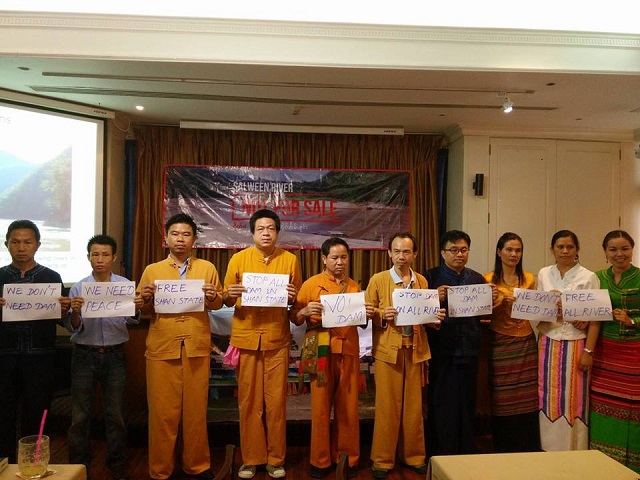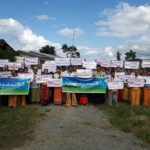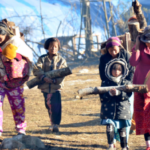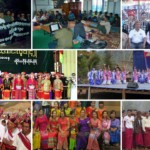Shan Herald Agency for News (SHAN) | August 24, 2016
Shan civic groups held a press conference in Bangkok today, claiming that the Burmese government, led by Aung San Suu Kyi, is working secretly in support of dam construction on the Salween River, despite knowing that the mega-project will greatly affect many people.
Speaking at the Foreign Correspondents Club of Thailand (FCCT) in the Thai capital, Sai Khur Hseng of the Shan Sapawa Environmental Organization and spokesperson for this morning’s joint-statement, said that the new Burmese government has tried to implement the hydropower projects without caring about the suffering of ordinary people.
“While all eyes were on the Irrawaddy- Myitsone dam, Burma has quietly sold off the Salween to China,” said Sai Khur Hseng. “We fear there has been a trade-off.”
“Amidst the war, Australia’s Snowy Mountains Engineering Corporation (SMEC) has been carrying out an Environmental and Social Impact Assessment (ESIA) for the Naung Pha Dam in secrecy, clearly to avoid the widespread grassroots protests that blocked its ESIA last year for another Chinese-backed dam on the Salween – the giant Mong Ton Dam in southern Shan State,” said the statement.
The civic groups said that on August 5, more than 200 residents Tangyan Township – an area in line to be flooded by dam construction – staged a protest. Also, on August 21, about 60 community leaders from Ho Pang, Kunlong, Tangyan, Hsenwi and Lashio, including local Shan Nationalities League for Democracy (SNLD) MPs, held a demonstration against the plans in Hsenwi Township.
Representing environmental organization International Rivers, Pianporn Deetes said that the Thai government has been attempting to foster good relations with Naypyidaw, and had also done so with the previous Burmese administration, led by President Thein Sein, in a bid to push forward its agenda of building dams on the Salween River.
The 3,000-kilometre Salween River, officially known in Burmese as the Thanlwin, is listed as the 25th longest waterway in the world, beginning in the Tibetan plateau, passing through southern China, Burma and the Thai border, before draining in the Andaman Sea.
“The Thai government is seeking to build at least three dams on the Salween River, including the Hatgyi Dam and Mong Ton Dam,” she said. “If the dams are built, there will be flooding in central Shan State.”
She continued: “About a million Shan people had to migrate to Thailand due to forced relocation by the Burma army in the past 20 years. These people have to become migrant workers who work in construction sites. If the dams are built, they cannot return home because their houses will be under water. Therefore, they have to live in Thailand permanently.”
Thai environmental activist Pianporn Deetes urged the hydropower investors, as well as both the Thai and Burmese governments, to deeply consider the local people’s needs when the dams are built.
“There will huge impact on the environment,” she added. “But, more importantly, there will be a huge impact on the Shan community as well as human rights abuses.”
Tuesday’s joint-statement read: “Apart from concerns that the dam will cause increased fighting and displacement, villagers are fearful of dam breakage in this earthquake and flood-prone area.
“Ho Pang, the main Wa township to be impacted by the Naung Pha Dam, has suffered flooding and several earthquakes in the last few weeks. Ho Pang lies on the Nam Ting fault line.”
Nang Charm Tong, a Shan activist and spokesperson for today’s event, said “As they
She added: “We strongly oppose this activity.”
On August 18, Shan Herald reported that 26 Shan-based organizations had sent an open letter to Burma’s State Counselor and Foreign Minister Aung San Suu Kyi, during her visit to China. The groups had demanded that the Burmese government immediately stop all the hydropower projects on the Salween River.
The blueprints for a hydropower project on the Salween include a series of dams in Shan State: the 7,100 megawatt Mong Ton Dam; the 1,400 MW Kunlong Dam; the 1,200 MW Nong Pha Dam; and the 200 MW Manntaung Dam. The project would also include plans for a 4,000 MW Ywathit Dam in Karenni State, and the 1,360 MW Hat Gyi Dam in Karen State. Investors in the projects include the China Three Gorges Corporation, a Chinese state-owned firm which operates the world’s largest dam on the Yangtze River. The other foreign firms involved in the Salween project are: Sinohydro; China Southern Grid; and a subsidiary of the state-run Electricity Generating Authority of Thailand.
Local partners are the Burmese Ministry of Electric Power and the International Group of Entrepreneurs (IGE), a firm controlled by the offspring of the late Aung Thaung, the long-time industry minister under Snr-Gen Than Shwe’s military regime.
According to the related contracts, when the projects are completed, 90 percent of the electricity generated is to be exported to China and Thailand.
This article originally appeared on Shan Herald Agency for News (SHAN) on August 23, 2016.







